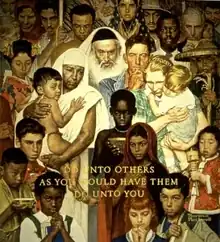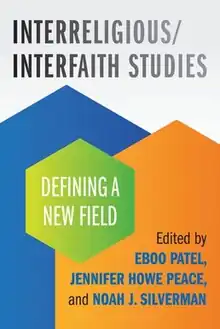Interfaith studies
Interfaith studies, or Interreligious studies, is a new and primarily evidence-based education interdisciplinary academic discipline that uses scientific methods to access social sciences and humanities in the development of rule of law nonviolence humanitarian aid social services cultural diplomacy, mainly through policymaking, multi-religious literacy, and interfaith education, always aiming at the common good in interpersonal relationships and communities organizing.[1]

Kate McCarthy of California State University, Chico states in the book Interreligious/Interfaith Studies: Defining a New Field that
interfaith studies is a subdiscipline of religious studies that engages in the scholarly and religiously neutral description, multidisciplinary analysis, and theoretical framing of the interactions of religiously different people and groups, including the intersections of religion and secularity. It examines these interactions in historical and contemporary contexts, and in relation to other social systems and forces. Like other disciplines with applied dimensions, it serves the public good by bringing its analysis to bear on practical approaches to issues in religiously diverse societies.[2]
Relevance for world affairs

International interfaith diplomacy
The area's importance was recognized by UNESCO's UNITWIN Network for Inter-Religious Dialogue and Intercultural Understanding (IDIU)[4] due to the large number of interreligious and interfaith International non-governmental organizations that use the area's qualitative research and data analysis. The Institute for Global Engagement (IGE) has reiterated the value of the faculty for International relations with the publishing of the "Interfaith on the World Stage" special edition of the Review of Faith & International Affairs.[5] Examples of interfaith study are the "Considerations and Guidance for the Humanitarian Engagement with Religious Leaders" of the University of York Generating Respect Project,[6] that assists the implementation of international humanitarian law, and the Search for Common Ground "Universal Code of Conduct for Holy Sites" development analyses.[7]
Higher education
According to the University of Amsterdam's Faculty of Religion & Theology, "Interfaith initiatives are seen as promising sites for societal change and personal transformation; however, many questions about the actual outcomes of such initiatives have remained unanswered."[8] This usage of interfaith diplomacy by the most varied different fields of humanity's enterprise without proper methodology, called many agents worldwide to develop dozens of nonformal education and higher education interfaith studies programs and journals now internationally unionized in the Association for Interreligious / Interfaith Studies (AIIS), that declares its own foundation historical necessity as the growing interest in the field professionalization at the American Academy of Religion (AAR)'s "Interreligious and Interfaith Studies Unit" forum.[9]

Historical
The World Congress of Religions had its inaugural summit in the 1893 Parliament of the World's Religions (PoWR), the first modern interfaith meeting.[10] This inspired the creation of the International Association for the History of Religions (IAHR), the first religious studies association, in the 1900 Religious History Congress in Paris. Throughout the twentieth century, interfaith studies has had the role of feeding religious studies, at the same time that defining rule of law compliance standards to it, through the analysis of its usage by interfaith-based organizations.
Organizational chaplaincy
The Religious Freedom and Business Foundation (RFBF)'s Corporate Religious Equity, Diversity & Inclusion (REDI) Index pledges that interfaith studies are important because of the relations between religion and health by stating that "religious freedom is the next diversity, equity, and inclusion (DEI) field of inquiry for environmental, social, and corporate governance (ESG), which is important also for non-governmental organizations.[11]
Personal affairs

Since there are an ever increasing number of Interfaith marriages, families, groups, communities, and civil movements worldwide, we also require further studies areas related to interfaith multi-religious education, as it is being developed by World Religions Education for Kids, Arigatou International Global Network of Religions for Children (GNRC)], and the United States Agency for International Development Freedom of Religion or Belief (FoRB) Learning Platform.
Methodology
Interfaith Studies is an Interdisciplinary teaching field that, through evidence-based education interdisciplinarity, uses scientific methods to inquiry on the multiple ways in which different Religious, spiritual, and secular identities (RSSIs)[12] influence how religious people, Faith-based organizations (FBOs), and interfaith-based organizations, who orient themselves around religious beliefs and laity, interact with one another and in interconvictional dialogue with nonreligious persons and institutions (including humanist, ethical, atheist, agnostic movements)[13] under the secular state rule of law. This includes the overall in-depth research and data analysis of:

- Nonviolence Peace and Conflict Studies
- Chaplaincy
- Religious Studies
- Psychology of Religions
- Science of Religion (Religious Experience Studies)
- Theology of Religions
- Religious Philosophies
- Atheology (Nonreligiosity Studies), including History of Atheism
- Humanities
- Intercultural Communication
- Anthropology of Religions
- Social Responsibility Effective Altruism
- Applied Theologies
- Glocal Religious Politics
- Religious Art Theopoetics, Curatorship and Social Ecomuseology
- Religious Heritage, including Sacred Natural Sites, Safeguard
- Religious Advocacy Groups Governance
- Multi-Religious Literacy
- Religious Education
- Interfaith Literacy Multi-Religious Pedagogy
- Cultural Diplomacy
- International Relations
- Planetary Management
- United Nations Studies
Bibliography
- "Interreligious/Interfaith Studies: Defining a New Field" by Eboo Patel & Kate McCarthy
- "Interreligious Studies: An Introduction" by Rachel Mikva
- "Interreligious Studies: A Relational Approach to Religious Activism and the Study of Religions" by Oddbjørn Leirvik
- "The Im-Possibility of Interreligious Dialogue" by Catherine Cornille
- Edicts of Toleration History Timeline
- "Interfaith on the World Stage" special edition of The Review of Faith & International Affairs by Institute for Global Engagement (IGE)
- "Student Voices in Interfaith Studies" Conference by Interfaith America (IA)
- "Considerations and Guidance for the Humanitarian Engagement with Religious Leaders" by the University of York's Generating Respect Project
- "Universal Code of Conduct for Holy Sites" by Search for Common Ground
- "Religion And Public Life Courses" by The Foundation for Religious Literacy
References
- "'What is Interfaith Studies?'". The University of Wales Interfaith Studies Cathedra Presentation.
- "About the Journal". Journal of Interreligious Studies.
- "Living the Golden Rule: An Interfaith Exploration". The Way of Wisdom.
- "Interreligious Reflections: The Process and Method of Collaborative Interfaith Research". Interculturalism at the Crossroads: Comparative Perspectives on Concepts, Policies and Practices: 277–298. ISBN 978-92-3-100218-2 – via UNESCO Publishing.
- "Interfaith on the World Stage". The Review of Faith & International Affairs. 16 (3).
- "Considerations and Guidance for the Humanitarian Engagement with Religious Leaders" (PDF). generatingrespectproject.org. Retrieved 6 October 2023.
- "Universal Code of Conduct on Holy Sites". Search for Common Ground.
- "Evaluating the Learning Outcomes of Interfaith Initiatives: A Systematic Literature Review". Journal of Beliefs & Values.
- "Association of Interreligious / Interfaith Studies (AIIS) History". Association of Interreligious / Interfaith Studies (AIIS) About Page.
- Savage, Minot Judson. The World's Congress of Religions. University of Illinois Urbana-Champaign and The Internet Archive. OCLC 1158492017.
- "REDI Index | RFBF". religiousfreedomandbusiness.org. December 12, 2019.
- "Interfaith Research Project".
- Minois, George. History of Atheism. ISBN 9788539305247.

